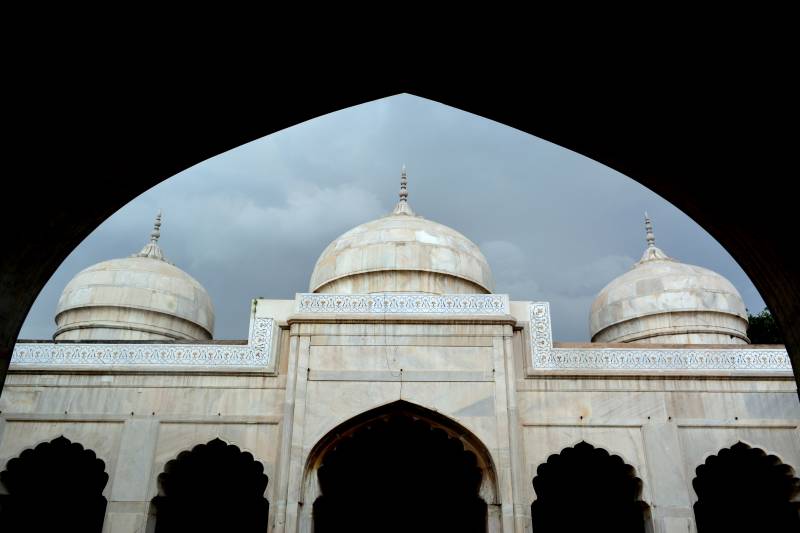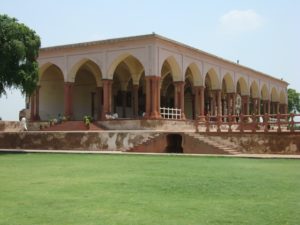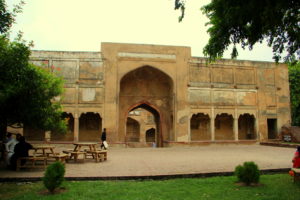
This is the third part of a series of features on the Lahore Fort. Read the first and second parts.
In part 1, I gave a brief account of the history of Lahore Fort, and in the second part, I wrote about the gigantic gates of the grand fort. Now I will take you to some mesmerizing places inside the Lahore Fort. I am sure that most these places would be familiar to you, but some of these must be new.
As you enter the royal fort through the British era Royal Ramp, you will reach the entrance of the Lahore Fort. Thereafter, you can easily see the glittering domes of Moti Masjid (the Pearl Mosque).
You enter into the Fort through the black fence and on your left will be an imposing structure which usually goes unnoticed by the visitors. Next time you are there, don’t miss to see its mesmerizing and captivating arches. This place is called Makatib Khana which was the Fort’s Secretariat in older times.
The word Makatib Khana means a clerk's room, or a secretariat. According to historic references this was a place where clerks (muharirs) recorded entry into the fort. A Persian inscription fixed on the façade of the vestibule tells that the palace was built under the orders of the emperor Jahangir in the year A.H. 1027 (1617) under the superintendence of the architect Ma’mur Khan.
The inscription which is carved in exquisite Nasta liq characters on the marble slab, English translate read as:
“In the twelve occasion of the blessed accession of his imperial majesty, the shadow of God, a Solomon in dignity, Kayumars in state, An Alexander in arms, the asylum of the Khlilafat emperor Nur ud din, son of emperor Jalal ud din, champion of the faith, corresponding with 1027, the building of the auspicious was completed under the superintendence of most humble disciple and slave, the devoted servant, Mamur Khan.”
The Makatib Khana is the special formation of Mughal emperors and best known historic part within Lahore Fort. The monument is a witness of the incomparable use of spaces, valued formation, and application of geometric proportions during the eminent era of Mughals. It is completely a sole combination of history, culture and architecture.
The massive entrance has central arched openings towards east. It faces an open courtyard, square on plan and having oblong vaulted chambers on the east west and north. Yet another high arched way leads to the main court of the Moti Masjid Quadrangle on its north. Presently the Makatib Khana is a single story building containing an open courtyard in the middle of building. The structure of the Makatib Khana has been built with the brick masonry and lime mortar.

On one side of the Makatib Khana is also the canteen of the Lahore Fort. Through that entrance you can take your way to the pearl mosque which is the Moti Masjid. This small and beautifully constructed mosque is said to have spirits and ghouls inside it. People visiting it have a strong belief that if Nawafil (Muslim Prayers) are offered at Moti Masjid, the wishes do come true. Having the same belief thousands of visitors from all over the world visits this place every week. During the Asr prayers you will hardly find a place to step inside the mosque.
Moti Masjid was built in 1645 by the Mughal Shah Jahan. As per historic accounts, it is stated that the mosque might have been built along with Dolat Khana Khaas-o-Aam of Shah Jahan.
It is one of those two mosques built in chaste marble by Shah Jahan. The second one was built at Agra Fort in 1654 AD. Mughal Emperor Aurangzeb also constructed a mosque of the same type at Red Fort Delhi in 1662 AD. They are all titled as Pearl Mosque because of their outlook imbued with white marble.
This mosque is exclusively built of Sang-e-Marmar Iie. the white marble. It was brought from Makrana, Rajhstan, India at the time of its construction. Makrana has always been prominent for the white marble taken from the mines around it. Marble from Makrana was also used in the construction of the Taj Mahal. Till today, you will see this marble glowing like a pearl and that’s the specialty of it.
Now cme to another wonder of Lahore Fort. Take you way towards the Deewan-e-Aam of Lahore fort which is the most visited and popular sites in Lahore fort. This hall of private audience was used by Akbar, Jahangir and Shah Jahan. The mix architecture reflects this fact.

The building was constructed in front of the Jharoka of Daulat Khana-e-Khas, built by Akbar occupying the middle of the northern side. Shah Jahan in 1631-3 ordered to construct the hall of forty pillars which was completed in three years under the supervision of Asif Khan (brother of Nur Jahan, the empress of Shah Jahan’s father, Jahangir).
Deewan-e-Aam was destroyed when Sher Singh (son of Raja Ranjit Singh) bombarded Lahore Fort by light guns fighting against Chand Kour the widow of Kharak Singh, the elder son of Ranjit Singh. The British rebuilt it after their occupation of the fort in 1849 A.D. The marble work in the state balcony in this area appears to be the earliest structural existing at Lahore Fort.
The classic building is constructed on a raised platform bounded by a stone railing. During the reigns of Akbar and Jahangir, the Deewan-e-Aam was enclosed with velvet canopies, shawls, ornaments and the floor was covered with rich carpets. However, among the first orders given by Shah Jahan as emperor was the instruction to replace the velvet canopy with a wooden hall.
Soon afterwards, however, a lavish 40-column hall was ordered to be constructed both in Agra and Lahore. While Shah Jahan’s Agra Deewan-e-Aam survives, only the columns and footprints of the one at Lahore are original. Various parts and additions in the building, arches and roof are British era construction. Remains of the original Mughal brick floor can be seen in one part of Deewan-e-Aam and are distinguishable from the remaining floor.
The Walled City of Lahore Authority restored some portions of this hall and more works will soon be done on it. Let me tell you that Makatib Khana, Moti Masjid and Deewan-e-Aam have also been illuminated by the Walled City of Lahore Authority for the first time in the history after partition.
In part 1, I gave a brief account of the history of Lahore Fort, and in the second part, I wrote about the gigantic gates of the grand fort. Now I will take you to some mesmerizing places inside the Lahore Fort. I am sure that most these places would be familiar to you, but some of these must be new.
As you enter the royal fort through the British era Royal Ramp, you will reach the entrance of the Lahore Fort. Thereafter, you can easily see the glittering domes of Moti Masjid (the Pearl Mosque).
You enter into the Fort through the black fence and on your left will be an imposing structure which usually goes unnoticed by the visitors. Next time you are there, don’t miss to see its mesmerizing and captivating arches. This place is called Makatib Khana which was the Fort’s Secretariat in older times.
The word Makatib Khana means a clerk's room, or a secretariat. According to historic references this was a place where clerks (muharirs) recorded entry into the fort. A Persian inscription fixed on the façade of the vestibule tells that the palace was built under the orders of the emperor Jahangir in the year A.H. 1027 (1617) under the superintendence of the architect Ma’mur Khan.
The inscription which is carved in exquisite Nasta liq characters on the marble slab, English translate read as:
“In the twelve occasion of the blessed accession of his imperial majesty, the shadow of God, a Solomon in dignity, Kayumars in state, An Alexander in arms, the asylum of the Khlilafat emperor Nur ud din, son of emperor Jalal ud din, champion of the faith, corresponding with 1027, the building of the auspicious was completed under the superintendence of most humble disciple and slave, the devoted servant, Mamur Khan.”
The Makatib Khana is the special formation of Mughal emperors and best known historic part within Lahore Fort. The monument is a witness of the incomparable use of spaces, valued formation, and application of geometric proportions during the eminent era of Mughals. It is completely a sole combination of history, culture and architecture.
The massive entrance has central arched openings towards east. It faces an open courtyard, square on plan and having oblong vaulted chambers on the east west and north. Yet another high arched way leads to the main court of the Moti Masjid Quadrangle on its north. Presently the Makatib Khana is a single story building containing an open courtyard in the middle of building. The structure of the Makatib Khana has been built with the brick masonry and lime mortar.

On one side of the Makatib Khana is also the canteen of the Lahore Fort. Through that entrance you can take your way to the pearl mosque which is the Moti Masjid. This small and beautifully constructed mosque is said to have spirits and ghouls inside it. People visiting it have a strong belief that if Nawafil (Muslim Prayers) are offered at Moti Masjid, the wishes do come true. Having the same belief thousands of visitors from all over the world visits this place every week. During the Asr prayers you will hardly find a place to step inside the mosque.
Moti Masjid was built in 1645 by the Mughal Shah Jahan. As per historic accounts, it is stated that the mosque might have been built along with Dolat Khana Khaas-o-Aam of Shah Jahan.
It is one of those two mosques built in chaste marble by Shah Jahan. The second one was built at Agra Fort in 1654 AD. Mughal Emperor Aurangzeb also constructed a mosque of the same type at Red Fort Delhi in 1662 AD. They are all titled as Pearl Mosque because of their outlook imbued with white marble.
This mosque is exclusively built of Sang-e-Marmar Iie. the white marble. It was brought from Makrana, Rajhstan, India at the time of its construction. Makrana has always been prominent for the white marble taken from the mines around it. Marble from Makrana was also used in the construction of the Taj Mahal. Till today, you will see this marble glowing like a pearl and that’s the specialty of it.
Now cme to another wonder of Lahore Fort. Take you way towards the Deewan-e-Aam of Lahore fort which is the most visited and popular sites in Lahore fort. This hall of private audience was used by Akbar, Jahangir and Shah Jahan. The mix architecture reflects this fact.

The building was constructed in front of the Jharoka of Daulat Khana-e-Khas, built by Akbar occupying the middle of the northern side. Shah Jahan in 1631-3 ordered to construct the hall of forty pillars which was completed in three years under the supervision of Asif Khan (brother of Nur Jahan, the empress of Shah Jahan’s father, Jahangir).
Deewan-e-Aam was destroyed when Sher Singh (son of Raja Ranjit Singh) bombarded Lahore Fort by light guns fighting against Chand Kour the widow of Kharak Singh, the elder son of Ranjit Singh. The British rebuilt it after their occupation of the fort in 1849 A.D. The marble work in the state balcony in this area appears to be the earliest structural existing at Lahore Fort.
The classic building is constructed on a raised platform bounded by a stone railing. During the reigns of Akbar and Jahangir, the Deewan-e-Aam was enclosed with velvet canopies, shawls, ornaments and the floor was covered with rich carpets. However, among the first orders given by Shah Jahan as emperor was the instruction to replace the velvet canopy with a wooden hall.
Soon afterwards, however, a lavish 40-column hall was ordered to be constructed both in Agra and Lahore. While Shah Jahan’s Agra Deewan-e-Aam survives, only the columns and footprints of the one at Lahore are original. Various parts and additions in the building, arches and roof are British era construction. Remains of the original Mughal brick floor can be seen in one part of Deewan-e-Aam and are distinguishable from the remaining floor.
The Walled City of Lahore Authority restored some portions of this hall and more works will soon be done on it. Let me tell you that Makatib Khana, Moti Masjid and Deewan-e-Aam have also been illuminated by the Walled City of Lahore Authority for the first time in the history after partition.
